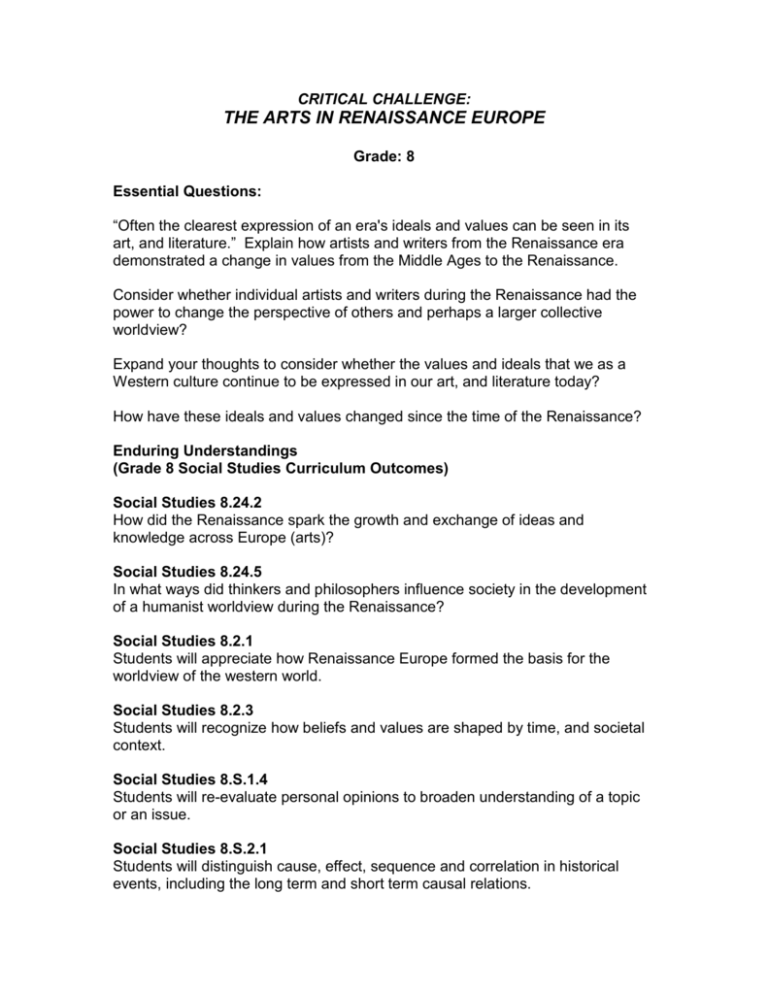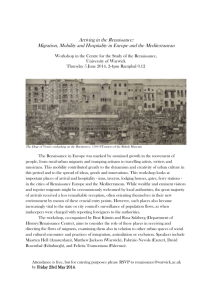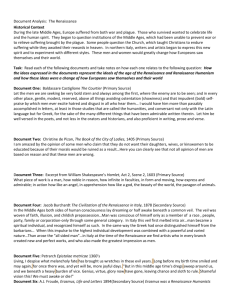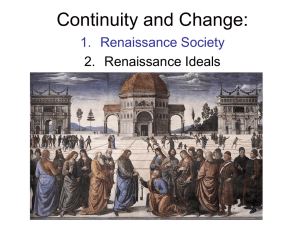The Arts in Renaissance Europe
advertisement

CRITICAL CHALLENGE: THE ARTS IN RENAISSANCE EUROPE Grade: 8 Essential Questions: “Often the clearest expression of an era's ideals and values can be seen in its art, and literature.” Explain how artists and writers from the Renaissance era demonstrated a change in values from the Middle Ages to the Renaissance. Consider whether individual artists and writers during the Renaissance had the power to change the perspective of others and perhaps a larger collective worldview? Expand your thoughts to consider whether the values and ideals that we as a Western culture continue to be expressed in our art, and literature today? How have these ideals and values changed since the time of the Renaissance? Enduring Understandings (Grade 8 Social Studies Curriculum Outcomes) Social Studies 8.24.2 How did the Renaissance spark the growth and exchange of ideas and knowledge across Europe (arts)? Social Studies 8.24.5 In what ways did thinkers and philosophers influence society in the development of a humanist worldview during the Renaissance? Social Studies 8.2.1 Students will appreciate how Renaissance Europe formed the basis for the worldview of the western world. Social Studies 8.2.3 Students will recognize how beliefs and values are shaped by time, and societal context. Social Studies 8.S.1.4 Students will re-evaluate personal opinions to broaden understanding of a topic or an issue. Social Studies 8.S.2.1 Students will distinguish cause, effect, sequence and correlation in historical events, including the long term and short term causal relations. Social Studies 8.S.2.3 Students will analyze the historical contexts of key events in a given time period. Social Studies 8.S.7.2 Students will develop a position supported by information gathered through research. Social Studies 8.S.7.3 Students will draw conclusions based upon research and evidence. Social Studies 8.S.8.1 Students will communicate in a persuasive and engaging manner through a written report. (ICT Curriculum Outcomes) ICT C.1 Students will access, use and communicate information from a variety of technologies. 3.4 access and retrieve information through the electronic network 3.5 analyze and synthesize information to create a product 3.6 communicate in a persuasive and engaging manner, through appropriate forms, such as reports ICT F.3 Students will demonstrate a moral and ethical approach to the use of technology 3.1 use time and resources on the network wisely 3.4 cite sources when using copyright and /or public domain material ICT P.1 Students will compose, revise and edit text. 3.1 Design a document, using style sheets and with attention to page layout, that incorporates advanced word processing techniques 3.2 use advanced word processing menu features to accomplish a task; for example, insert a table, graph, or text (image) from another document 3.3 revise text documents based on feedback from others Assessment Targets: Students will be assessed primarily on their ability to argue or demonstrate how the collective group of artists and writers of the Renaissance period have influenced the ideals and values of others during that time frame and also how well the student can make a relationship to the values and ideals of the Renaissance to the values and ideals of today. Critical Challenge: Record your reflective response to the following questions in a persuasive essay. (Suggested length of response is approximately 500 - 800 words.) (Format Microsoft Word Document) “Often the clearest expression of an era's ideals and values can be seen in its art, and literature.” Use the visual and text examples provided in the web links posted to explain how artists and writers from the Renaissance era demonstrated a change in values from the Middle Ages to the Renaissance. Consider whether individual artists and writers during the Renaissance had the power to change the perspective of others and perhaps a larger collective worldview? Expand your thoughts to consider whether the values and ideals that we as a Western culture continue to be expressed in our art, and literature today? How have these ideals and values changed since the time of the Renaissance? Subtasks: What students will do? Task One: Use the following Filamentality Sampler on Renaissance Art, at: http://www.rebooting.ca/carc/grade8 Part 1: Miracle of the Thirsty Man: Giotto Part 2: The Mona Lisa by Leonardo Da Vinci Part 3: The Last Supper by Leonardo Da Vinci Part 4: Michelangelo’s Sistine Chapel: Ceiling Frescoes Part 5: Michelangelo’s Sistine Chapel: Creation of Adam Part 6: Old English Poetry example Part 7: Christopher Marlowe: The Passionate Shepherd to His Love Part 8: Sir Walter Raliegh: The Nymph’s Reply to the Shepherd Part 9: Edmund Spenser: from Amoretti Sonnet 30 Part 10: William Shakespeare: Sonnet 18 Part 11: Pertrarch: Sonnet 140 Task Two: Renaissance Poetry Students will replicate a version of Renaissance poetry that demonstrates their knowledge of the themes and formats of Renaissance Writing. Students will have the choice of a ballad, Petrarch Sonnet or a Shakespearian Sonnet. Task Three: Persuasive Essay Record your reflective response to the following questions in a persuasive essay. (Suggested length of response is approximately 500 - 800 words.) (Format Microsoft Word Document) “Often the clearest expression of an era's ideals and values can be seen in its art, and literature.” Use the visual and text examples provided in the web links posted to explain how artists and writers from the Renaissance era demonstrated a change in values from the Middle Ages to the Renaissance. Consider whether individual artists and writers during the Renaissance had the power to change the perspective of others and perhaps a larger collective worldview? Expand your thoughts to consider whether the values and ideals that we, as a Western culture share, continue to be expressed in our art, and literature today? How have these ideals and values changed since the time of the Renaissance? Supporting Instructions: What the teacher needs to do to support the students? - Watch A & E Biography videos on Leonardo Da Vinci, Michelangelo, and Shakespeare - Background knowledge on using internet - Background knowledge on word processing use and importing of images - Background knowledge on proper documentation of image sources - Background knowledge on Persuasive writing - Background knowledge on Creative writing i.e. poetry - Background knowledge on the humanist movement and the origins of the Renaissance - Rubric Creation with students on Persuasive Essay (Task Three) - Rubric Creation with students on Poetry Assignment Picture References: www.essential-architecture.com/DAVINCI/DV14.htm - Da Vinci www.factropolis.com/.../2006_12_01_archive.html - Michelangelo forum.quoteland.com/1/OpenTopic?a=tpc&s=58619... – Petrarch en.wikipedia.org/wiki/Giotto_di_Bondone – Giotto www.crrs.ca/events/newsletterarchive/2006-05.htm - Shakespeare www.walterscott.lib.ed.ac.uk/.../spenser.html - Spenser caxton.stockton.edu/jewofmalta/ - Marlowe www.elizabethan-era.org.uk/sir-walter-raleigh.htm - Raleigh www.marcdatabase.com/.../garret/portraits/ - Chaucer www.wildlife-fantasy.com/artwork/beowulf.php - Beowulf








